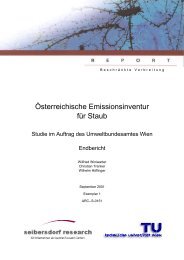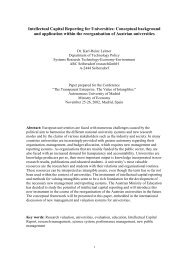ALPMON FINAL REPORT - ARC systems research
ALPMON FINAL REPORT - ARC systems research
ALPMON FINAL REPORT - ARC systems research
Create successful ePaper yourself
Turn your PDF publications into a flip-book with our unique Google optimized e-Paper software.
Contract ENV4-CT96-0359 <strong>ALPMON</strong><br />
3.3.9.2 Modelling of water run-off<br />
Methods for the extraction of information from remote sensing data as well as data layers needed to<br />
run ASGI have been delivered to the customer. The project work offered the opportunity to investigate<br />
the specific limitations but also chances given by the alpine environment and to discuss the problem of<br />
parameter extraction from remote sensing data with different potential.<br />
Furthermore a review on the existing administrative data layers including accuracy assessment of this<br />
data have been performed and recommendations for the appropriated method for the divers preprocessing<br />
and processing steps have been elaborated.<br />
The Sulm test site study demonstrates the full evaluation chain with the ASGI water run of model. To<br />
operate the model time series of precipitation, air temperature and runoff were prepared. Besides the<br />
time series data, spatial data on various parameters are required for the model. Following spatial<br />
source data sets were derived in a first step: Landcover from Landsat TM data, DEM from the 1:50.000<br />
scale national map series, and soil type information estimated from the digital geological map 1:50.000<br />
and already available point-wise analysed soil profiles.<br />
Meteorological time series data for precipitation and temperature were delivered from the Section of<br />
Water Resources. Shell script programming was done to check for various errors (e.g. negative<br />
precipitation values, revised time order) in the data. The remaining plausible time series data were then<br />
pre-processed in the ASGI environment. As only 7 precipitation stations remained with reliable data,<br />
IDW-Interpolation was selected as interpolation method. Also temperature time series data were<br />
interpolated with IDW.<br />
The potential evaporation was calculated after Hamon (Federer & Lash, 1983). This model includes in<br />
addition to the temperature (IDW-interpolated as described above), an empirical monthly correction<br />
factor fi.<br />
Estimation of the interception storage capacity is based on leaf area index, degree of vegetation<br />
coverage and height of water stored on the surface. Leaf area index LAI (based on Thompson et al.,<br />
1981) and degree of vegetation coverage were derived from the landcover classification results.<br />
For the Sulm catchment (and Austria in general), soils of agricultural areas are mapped with high level<br />
of detail in a scale of 1:2.500. Soils in forests and alpine regions, however, are in general only sampled<br />
in 4km by 4km grid. Up to now, no full area covering soil information is available which would be an<br />
appropriate basis for hydrological modelling in meso-scale catchments. As the basis for the estimation<br />
of soil-types, the soil-type map of Styria 1:1.000.000 (Krainer et al., 1998), the geological map of Styria<br />
1:50.000 in digital format, and point-wise available soil analysis data (Krainer et al., 1998) were used.<br />
The result is an “estimated soil type distribution” of the catchment area, with the 1:50.000 scale of the<br />
geological map and the soil type information of the 1:1.000.000 scale soil type map. The so derived<br />
parameters can only give a rough estimate of the actual soil parameters. However, major<br />
improvements on the soil type distribution information, e.g. detailed delineation of valley bottoms,<br />
alluvial cones etc. result from this procedure.<br />
The applied TOPMODEL approach is based on the saturated area approach using the topographic<br />
index after Beven and Kirkby (1979). This statistically based model differs from earlier soil-vegetation<br />
process models by including spatial variations in the main driving processes and uses topographic<br />
HRU’s to calculate lateral soil water transport. The recession parameter m was determined by slope<br />
hydrograph analysis. The main parameter of the TOPMODEL approach, the soil-topographical index,<br />
has been derived from the DEM.<br />
All these methods delivered the necessary parameters for running the ASGI model properly.<br />
Distributed models such as ASGI require land cover data for parameterisation. The use of earth<br />
observation data can be seen as an important pre-requisite for such models, as the spatial data<br />
demand for large area applications could hardly be satisfied without earth observation derived data<br />
sets (compare e.g. cost-estimates for land-cover mapping given by Konecny, 1995) . This leads to the<br />
conclusion that earth observation data support the application of distributed models, thus extending the<br />
toolbox of hydrologists.<br />
3.3.9.3 Avalanche risk<br />
Different types of avalanche risk models are currently developed at the Austrian Institute for Avalanche<br />
and Torrent Research, who was the national customer of this feasibility study. All models need similar<br />
parameters from remote sensing and DEM sources. Among these, the actual information on land<br />
JR, RSDE, ALU, LMU, Seibersdorf, WSL 81




